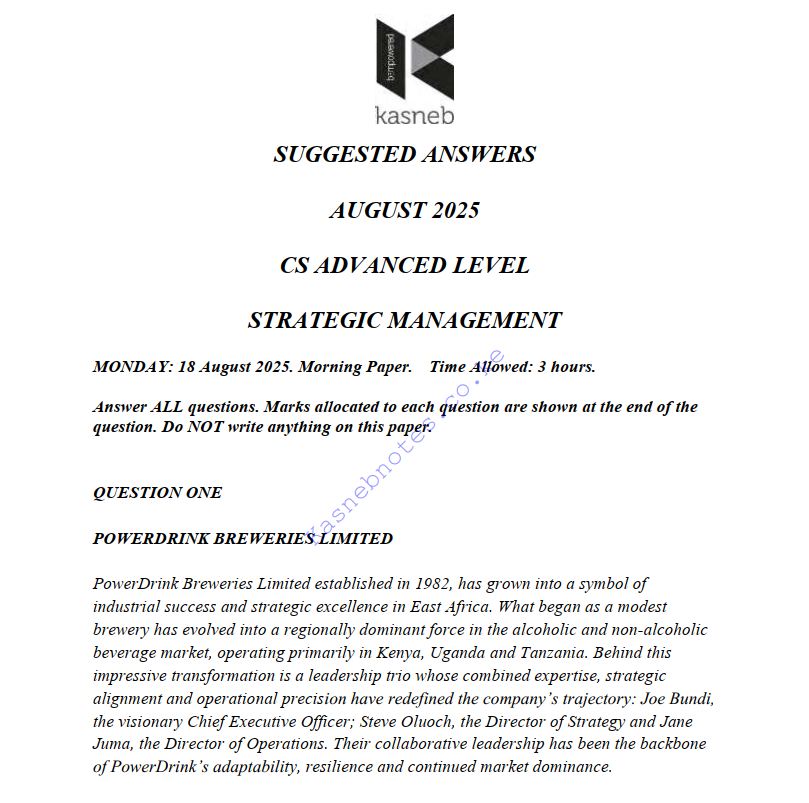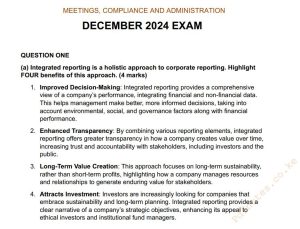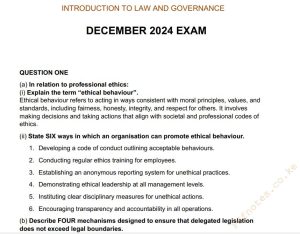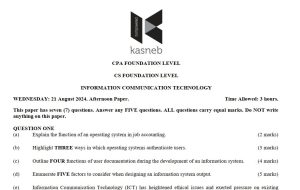Original price was: KSh500.KSh299Current price is: KSh299.
Download August 2025 Strategic Management Past Paper answers in Pdf form
Description
QUESTION ONE
POWERDRINK BREWERIES LIMITED
PowerDrink Breweries Limited established in 1982, has grown into a symbol of industrial success and strategic excellence in East Africa. What began as a modest brewery has evolved into a regionally dominant force in the alcoholic and non-alcoholic beverage market, operating primarily in Kenya, Uganda and Tanzania. Behind this impressive transformation is a leadership trio whose combined expertise, strategic alignment and operational precision have redefined the company’s trajectory: Joe Bundi, the visionary Chief Executive Officer; Steve Oluoch, the Director of Strategy and Jane Juma, the Director of Operations. Their collaborative leadership has been the backbone of PowerDrink’s adaptability, resilience and continued market dominance.
Joe Bundi’s tenure as CEO has marked a period of transformation and sustainable growth. With over two decades of experience in the consumer goods and beverages industry, he has been instrumental in redefining the company’s purpose and guiding it through regulatory shifts, digital disruptions and regional market volatility. He is known for his inclusive leadership style and a strong belief in aligning business success with community well-being. Under his leadership, the company has embraced a forward-looking culture grounded in innovation, accountability and local relevance. Steve Oluoch, the Director of Strategy, brings a unique blend of local understanding and global strategic thinking. Steve introduced a dual-pronged strategy of differentiation and cost leadership, creating segmented product offerings that serve both premium and budget-conscious markets. Products like PowerKeg, aimed at low-income earners and the upscale Heritage Reserve line are direct results of his market segmentation efforts. Steve also led the rollout of the company’s “local-first” strategy, advocating for the localisation of raw material sourcing and flavour profiles to reflect regional tastes#8211; strengthening both brand identity and supply chain efficiency.
One of Steve’s major contributions has been spearheading PowerDrink’s digital transformation. He championed platforms such as “SmartBars”, which digitised the B2B relationship with retailers and integrated artificial intelligence- driven marketing tools to personalise consumer engagement. His strategic vision has enabled the company to respond nimbly to changing market dynamics, particularly during the COVID-19 pandemic when e-commerce and data analytics became central to survival and growth. Operationalising these bold strategies is Jane Juma, the Director of Operations, Jane, a logistics and process optimisation expert, has played a critical role in ensuring that the company’s strategic ambitions translate into measurable outcomes. She led the modernisation of the company’s bottling plants, introduced lean supply chain models and championed operational sustainability through initiatives like circular packaging and efficient water usage programs. Her execution of green technologies has allowed the company to meet and exceed ecological compliance standards in Kenya and across the region.
Jane’s ability to deliver efficiency at scale has made her a pillar of PowerDrink’s strategic execution. Together, Joe, Steve and Jane have cultivated a culture of strategic synergy that is central to PowerDrink’s continued success. Their roles are distinct, yet deeply interconnected. Joe sets the long-term vision and ensures stakeholder alignment. Steve designs the competitive roadmap, identifies growth opportunities and ensures adaptability. Jane brings it all to life- delivering on product quality, operational resilience and sustainability goals. This cross-functional collaboration was clearly evident during the company’s expansion into non-alcoholic beverages and ready-to-drink (RTD) segments. Steve identified the opportunity through market analytics, Jane implemented new production lines and distribution frameworks and Joe secured partnerships and regulatory clearances. The seamless interplay among the three leaders turned a bold strategic move into a profitable product category. Under their leadership, PowerDrink has successfully navigated a challenging PESTEL environment. The company has remained compliant and proactive in adapting to excise tax changes and regulatory shifts. It has tapped into the expanding urban middle class while buffering against inflation and currency fluctuations. Trends like health consciousness and premiumisation have been addressed through product innovation, while technology has been harnessed to enhance customer experience and operational transparency.
At the corporate strategy level, PowerDrink follows a model of related diversification, focusing primarily on beverages while exploring adjacent growth opportunities. Acquisitions such as the full ownership of Nile Spirits and the development of a high-tech spirits plant in Kenya, reflect this deliberate move toward vertical integration and market consolidation. Guided by Hofstede`s cultural dimension`s theory, the company’s international strategy remains regionally focused, targeting East and Central Africa. Steve ensures that each new market entry is context-sensitive, Jane ensures operational readiness and Joe cultivates high-level stakeholder relationships which allows the company to expand without diluting its brand or overextending its resources.
Internally, PowerDrink’s organisational culture which is rooted in performance, inclusion and innovation has become a critical asset. Joe’s leadership promotes a values-based approach that celebrates diversity and responsibility. Jane has implemented mentoring programs that empower junior staff and improve retention, while Steve has created strategy forums that encourage idea-sharing across departments. Their shared leadership philosophy fosters loyalty and reduces organisational silos. The company operates through a matrix structure with strategic oversight from Nairobi. Each subsidiary such as those in Uganda and Tanzania has local autonomy but aligns closely with the group’s overarching goals. This balance allows for agility and cultural sensitivity while ensuring brand consistency and financial accountability. The synergy at PowerDrink has allowed it to not only withstand industry headwinds, but to innovate, grow and lead, offering a compelling case study on how integrated leadership can transform a regional brand into an industry benchmark for excellence and resilience.
Required:
(a) Explain FIVE drivers of change that PowerDrink adopted in their impressive transformation journey. (10 marks)
(b) Discuss FIVE risks associated with the diversification model that PowerDrink follows at the corporate strategy level. (10 marks)
(c) The company operates through a certain structure with strategic oversight from Nairobi.
Examine FIVE features of this structure. (10 marks)
(d) Assess FIVE dimensions of the theory that guided international strategy at PowerDrink. (10 marks)
QUESTION TWO
(a) Wananchi Global Ltd. is conducting a competitive analysis for its 2026-2031 strategic plan.
Outline FIVE sources of competitive intelligence. (5 marks)
(b) Identify FIVE strategies that a company may adopt to achieve global expansion.
(5 marks)
(c) Explain FIVE roles of issue-selling in strategic management. (5 marks)
QUESTION THREE
(a) Describe FIVE circumstances that could lead to the development of emergent strategies. (5 marks)
(b) Explain FIVE challenges organisations may face when developing a mission statement. (5 marks)
(c) Assess FIVE strategies that could prevent organisational politics in the corporate world. (5 marks)
QUESTION FOUR
(a) Summarise FOUR features of a differentiation strategy. (4 marks)
(b) Patterns of strategy development refers to the different ways strategies are formed and evolve within organisations.
With reference to the above statement, outline FIVE patterns of strategy development.
(5 marks)
(c) Explain SIX benefits of the Boston Consulting Group (BCG) matrix to an organisation. (6 marks)
QUESTION FIVE
(a) Identify FOUR components of distinctiveness of resources as a source of competitive advantage in organisations. (4 marks)
(b) Outline FIVE financial metrics that may be used to measure corporate performance.
(5 marks)
(c) The VUCA model, originated in the US Army War College in the 1990s and was later adopted by strategic leadership within various organisations to address issues pertaining to uncertainty.
Analyse THREE components of this model. (6 marks)




